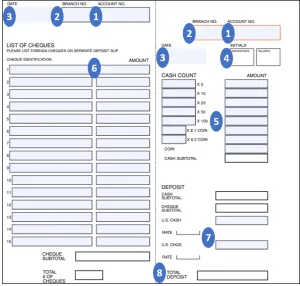 BMO Performance Chequing Account
BMO Performance Chequing Account
Bank deposit slips are used to add cash or cheques to your chequing or savings accounts. It only takes a couple of minutes to fill out—but most banks will let you deposit cheques through a mobile banking app, ATM or teller if you’d rather skip it altogether.
What is a deposit slip?
A bank deposit slip can be used to add funds to your bank account. You can deposit cash and cheques on the same deposit slip. Most banks will also let you request to withdraw cash from a cheque you’re depositing on the slip.
Deposit slips can be used at a bank branch or at certain ATMs. If you’re depositing a cheque or cash at an ATM, check that the ATM accepts deposits and whether you’ll need an envelope to keep your deposit slip and money together.
 BMO Performance Chequing Account
BMO Performance Chequing Account
What is the difference between a cheque and a deposit slip?
A cheque is a written order that tells the bank to withdraw money from the account of the person who wrote it and pay that amount to the person who deposits it.
A deposit slip is a form used when you want to add money to your own bank account. Essentially, a cheque moves funds out of an account, while a deposit slip helps record and direct funds into an account.
How do I fill in a deposit slip?

Completing a deposit slip may require that you provide:
1. Account number
Enter the account number where you want the money deposited. You may need to enter it on both the cheque and cash sides of the slip. If you’re not sure what your account number is, you can find it on one of your own cheques, through your bank’s online banking platform or by asking a bank teller.
If you want more information on what information is included on a blank cheque or how to properly fill one out, check out our other article.
2. Branch (transit) number
You should be able to find your branch number near the account number at the bottom of your cheque, in your online banking account or by asking a teller. It’s typically a 5-digit number that helps the bank identify exactly which branch your account is tied to, so your deposit goes to the right place.
3. Date
Always write the date you’re making the deposit, not the date shown on the cheque. This helps the bank track when the transaction took place and avoids any confusion.
4. Initials
Depending on your bank, you may be required to provide your name, initials and signature. This serves as an added security measure, confirming that you’re the person making the deposit.
5. Cash
Enter the amount of cash you’re depositing, including change. Like in the example above, you may have to enter the number of each type of bill and coin under the Cash Count column. In the Amount column, you would write the total value for each type of bill or coin.
For example, if you were depositing three $5 bills, you would write 3 under Cash Count and $15.00 under Amount. Then, enter the total amount in both Cash Subtotal lines by adding up all of the bills and coins.
6. Cheques
Write the value of each cheque in the Amount column on separate lines. Under the Cheque Identification column, write the cheque number. The cheque number is a unique identifying number printed on every cheque in a cheque book. It’s usually printed in the upper right corner of the cheque and as the first set of numbers along the bottom. Add up the total amount of all cheques to write in both Cheque Subtotal lines.
7. US Cash or Cheques
Your deposit slip may give you the option to deposit US cash or cheques. Like in the example slip above, you would need to write the total value of US cash and US cheques in the appropriate lines. You can also include the exchange rate in the Rate line.
8. Total deposit
Write the total amount you’re depositing into your bank account on the line / in the box at the bottom by adding up all cash and cheques.
Do banks in Canada still use deposit slips?
Deposit slips were once an essential part of everyday banking in Canada, but they’re largely outdated now. They were used to help customers and banks keep accurate records, ensure money was deposited into the correct account and acted as proof of deposit for future reference.
Now, ATMs automatically link deposits to your account using your debit card, and online banking provides instant digital records. Teller-assisted deposits are also tracked electronically, so there’s no need for a handwritten slip.
While a few banks may still provide deposit slips in certain circumstances, like business deposits or for customers who prefer paper records, they’re mostly unnecessary now.
Alternatives to deposit slips
Instead of filling out a paper deposit slip to put money into your account, you can use:
- Mobile banking apps: Many banks let you deposit cheques by simply taking a picture of the front and back through their mobile app. The funds are then processed and tracked digitally. If you’re not sure how to deposit a cheque online, check out our guide for step-by-step instructions.
- ATMs: Most ATMs accept both cash and cheque deposits. Since your debit card is linked to your account, the ATM automatically records the deposit without the need for a slip.
- A teller: If you prefer in-person banking, a teller can help you deposit your cheque. You just need to provide your bank card, which will instantly tie the transaction to your account so you can see the deposit on your mobile banking app or next statement.
Bottom line
Depositing cash or cheques into your bank should be simple, but the deposit slips and electronic options can vary from bank to bank. If you make regular deposits, talk with your financial institution about the most efficient way to handle your finances. And if you’re looking for a new bank, compare banks to find one that’s the right fit for you.
Frequently asked questions
Sources
More guides on Finder
-
How to choose the best bank for daily banking
Your guide to finding the best bank in Canada for personal banking and managing your money.
-
Tangerine new account offers and promotions
Explore all of the latest Tangerine new account offers and promotions available now.
-
Easiest bank account to open online in Canada
Compare six bank accounts that are quick and easy to open online.
-
The best banks in Canada for 2025
We compare Canada’s best banks to help you find your perfect banking match.
-
Scotiabank promotions and offers
Explore all the latest Scotiabank promotions and offers available now.
-
16 best new bank account offers for December 2025
Earn cash, rewards points, bonus interest rates and more with these new bank account offers and promotions.
-
Bank of Canada interest rate forecast report
Read Finder’s BoC Interest Rate Report for forecasts from some of Canada’s brightest minds in economics and learn more about how recent rate increases could affect Canada’s real estate market.
-
Environmentally friendly banking
Learn about green banking that supports an eco-friendly lifestyle plus compare environmentally friendly banking options from major banks.
-
Open a bank account online in Canada in 5 easy steps
Compare and open a bank account online in Canada in as little as 5 minutes. Learn what you need to apply and how to get started today.
-
Best joint bank accounts in Canada for 2025
Opening a joint bank account is a big step for any couple. Find out more about what to look for in an account and how to avoid the common pitfalls.

